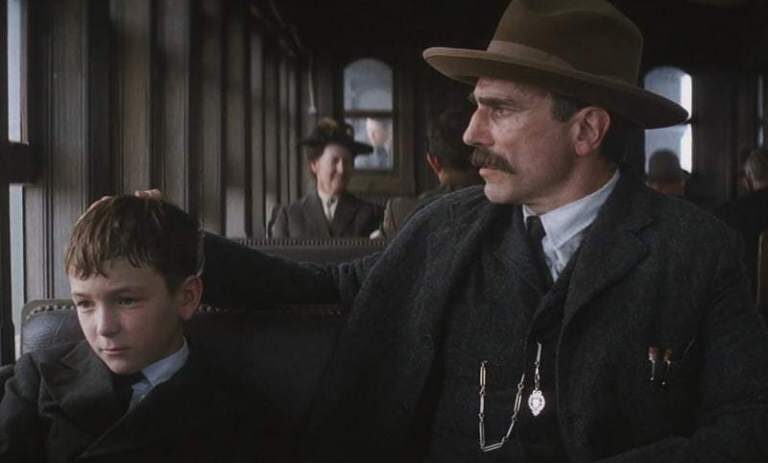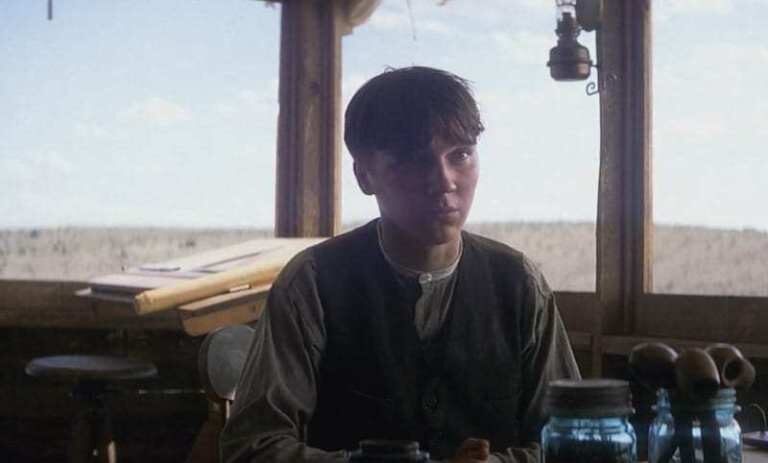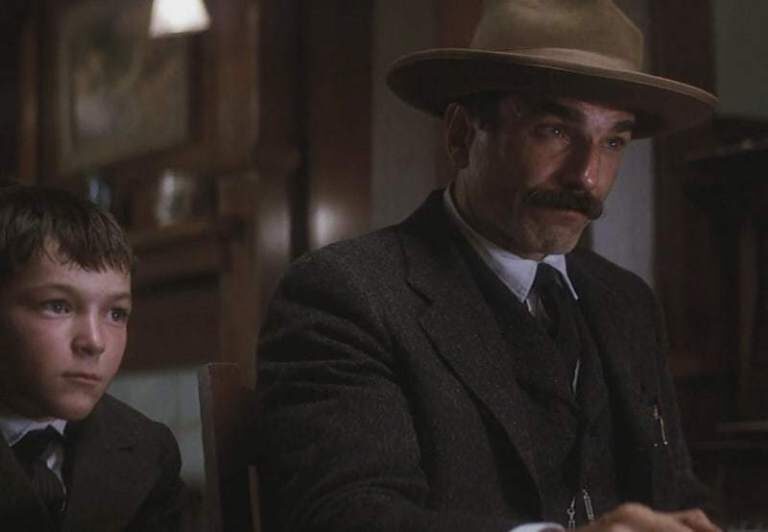Status and Signifiers: Costume in There Will Be Blood | Clothes on Film
Costume designer Mark Bridges described There Will Be Blood (2007) as his most challenging film, referring to the difficulties he faced in transporting costumes to the remote location in West Texas, after director Paul Thomas Anderson called for a new concept three days before a re-shoot. However these challenges seem to channel the themes of the film itself: hardship, isolation, and the determination to overcome any obstacle to fulfil a goal.
Daniel Plainview (Daniel Day-Lewis) is a turn-of-the-century prospector, who receives a tip about a giant oil deposit under a family farm in California. The family includes Eli Sunday, a zealous preacher and faith healer who wants the money from the sale of the property to finance his church of the Third Revelation. The two men clash repeatedly as both refuse to give in to the will of the other. Through betrayal, anger and violence, they both ultimately become victims of their ambition, finally losing all the things that gave them strength. Eli desperately admits to a crisis of faith, and Daniel, once he has killed Eli, states, “I’m finished.” The man who defined himself through competition has beaten his last opponent. The challenge of costuming this film lies in creating strong identities for these characters in a time and place when the luxuries of clothing were heavily restricted. In the democratised dress of 1910s California, variations of class, occupation, character and motivation are displayed through a “world of nuances and details.” In the absence of explanatory dialogue, Bridges also utilises the strong visual significations of certain items of dress to show developments in narrative. This combination of subtle details and immediate impact creates characters that are boldly idiosyncratic, yet grounded in the gritty realism of the story.
The film starts with two scenes from the earlier stages of Daniel Plainview’s career in 1898 and 1902, before moving to 1911, the year in which most of the story is set. In 1898, Daniel is seen working alone at the bottom of a pit, wearing the typical clothes of the manual labourer. Brown nondescript cinchback trousers, suspenders (braces), a soft felt hat with a wide brim to block the sun, union suit or ubiquitous blue smock shirt with baggy sleeves. This outfit, and variations of it, will be repeated throughout the film as stock clothes for Daniel’s workers. The fact that we first see him dressed this way tells us that he is from the same background, and that it is through his own strength and determination that he was able to rise to the level where he no longer has to undertake physical labour. The rise becomes evident in 1902, when Daniel, now able to hire a few workers, travels on a train with his adopted son HW. Men with socio-economic aspirations tried to emulate the respectable dress of the middle class and Daniel’s dark sack suit and hat with tall crown and short brim signals his ambitions and growing status. Its shabbiness however indicates his still relatively humble status, contrasting sharply with his suit of 1911.
Bridges described Daniel’s 1911 suit as being one of his few luxuries on the film, as he was able to have it custom-made, and the fabric custom-woven. Though this is perhaps not obvious on film, the fact that the suit is tailored to Daniel’s tall, lean frame, as well as being in a fabric that no other character wears helps to differentiate Daniel as uniquely important. The suggestion that he may have custom-ordered this suit indicates his wealth, and the ‘completion’ of his suit from 1902: a waistcoat, tie, stiff-brimmed hat and pocket watch concludes an impressive appearance of respectability. A white shirt also suggests that Daniel can now afford not to get dirty in his work. In addition to his suit, Daniel’s need to impress is evident in Bridge’s costume for the young HW. Daniel uses HW as a showpiece, to create sympathy in others and convince them of the ‘family’ nature of his business. The clothes are very smart, with a double-breasted coat, white shirt and shorts. There is no hint of labour or hardship, suggesting the success of his father’s business.
The suit’s importance as a tool for projecting power and status is emphasised by the fact that Daniel only wears it at business meetings (such as the one with Standard Oil), important events (the opening of the new drill) and in church. By eschewing the suit and white shirt for more everyday wear, it shows that despite his success he is still willing to be involved in hard work. The suit therefore does not signal a desire to achieve a more leisurely, middle class lifestyle, but instead is viewed merely as another tool for business. Daniel’s independence and pride in his work can be seen particularly in the detail of his collar and tie in the meetings with Standard and Union Oil. Unlike the other businessmen who wear detached, starched collars and silk ties with a pin, Daniel continues to have unstarched attached collars on his shirts and a plain black tie. This indicates that he is a man of function and efficiency who has little time or want to deal with the non-essential elements of smart dress. The sweat stains on the band of his hat also indicate not only hard work, but also Daniel’s lack of shame in showing this.
When not in a suit, Daniel still retains authority on the drill site through a combination of accessories that are both necessary and indicate his status in the chain of command. A pocket-watch on a chain as well as at least two fountain pens are always present, which act both as a signal of wealth and as useful items for Daniel in managing the business. The importance of being immediately recognisable from a distance is shown through the creation of an idiosyncratic silhouette, the combination of jodphurs and calf-length tightly laced boots emphasising the actor’s dimensons. The sense of purpose and control that the boots convey is displayed in their close-up during the meeting with Union, which cuts to show Daniel standing on the table, hammering a metal pike into a map to indicate success. The fact that Daniel almost never removes his hat is also significant. Common codes of etiquette often dictate that hats should be removed indoors, or when others have removed theirs’, such as the meeting with Standard. However Daniel refuses to do so, indicating his need to appear as the one in control of any situation. The only territory in which he is obliged to relinquish control and remove his hat is in that of Eli’s church.
When Eli first meets Daniel, he is wearing long underwear, suspenders, and baggy black trousers that are too short and flap around the ankles. There is nothing to suggest that this character is a threat or in any way different to his twin brother. This lack of signification means that Daniel is caught off-guard when Eli challenges him about the purchase of the land and states that the money should go to his church. Eli’s dress in his capacity as a pastor consists of black trousers, a black waistcoat, and white shirt with a small round collar that suggests a dog collar. The slightly ill fitting nature of Eli’s clothes belies the authority that he tries to convey, particularly in the presence of Daniel in his tailored suit. It also echoes Bridges’ idea that Eli received clothes as donations from some of his parishioners, being too poor to purchase them himself.
The dialectic of new clothes vs. old in reference to power and wealth is particularly emphasised when the drill is opened. Daniel ignores Eli’s request to bless the well and instead makes a speech whilst inviting Mary, Eli’s younger sister, to stand by him. Mary is in a bright white dress, a stark contrast to the faded, dirty pink dress she usually wears. It is later revealed that Daniel has bought this dress for Mary, mentioning this in front of Mary’s father, whom he knows beats Mary. His veiled assertion of ‘no more beating’ acts as a subtle threat towards the father, anchored by the purchase of the dress, which suggests wealth, power, and Daniel’s interest in the wellbeing of Mary. It is also acts symbolically as a snub towards Eli, emphasising his disregard for the money Eli is requesting.
Mary’s costume is used again near the end of the film to signify a considerable time shift, as well as the development of narrative. The scene cuts from Mary and HW playing together as children, to an adult woman in a white dress and veil. Because of the strong symbolism associated with these clothes, we immediately understand that this is a grown Mary marrying HW. HW himself is shown to be slowly filling his father’s shoes, wearing a dark functional suit without a tie (despite the obvious wealth that the large house signifies) and a few pens in his pocket. This becomes sharply contrasted to the appearance of Daniel himself, when we seem him shooting bottles in his house in his underwear and a shawl neck cardigan. The success of his business means that his work has been reduced to sitting at a desk signing papers. His identity had been defined by his work, and the dishevelled nature of his costume displays his inability to deal with this excess of leisure time. The cardigan is the antithesis of Daniel’s fitted dark suit, suggesting both his boredom and the lack of anyone to impress. This disregard for appearance is then contrasted with that of Eli’s. Eli wears a black suit and tie with large white collar, his hair fashionably slicked back and a large crucifix hanging around his neck.
However this appearance of success quickly crumbles when Daniel forces Eli to reveal that he has lost his money and is suffering a crisis of faith. On closer inspection his clothes appear slightly shabby, and trousers have clearly been taken up several times. The chain of the crucifix seems quite small, so hangs awkwardly over his collar. The absurd size of the cross can also be taken as a form of compensation for Eli’s spiritual problems.
By the end of the film, both Eli and Daniel have lost control over their ambitions. Even Daniel’s boots are un-laced, their flapping tongues suggesting indifference or clear direction. What Mark Bridges managed to achieve in There Will Be Blood is design costumes that respect the stark realities of the period whilst utilising the details available to signal developments in status, motivation and mental state. Understanding the symbolic difference between laced and unlaced boots, the cut of a jacket and the brim of a hat helped Bridges create a rich semiotic language that allow viewers to instantly read characters and scenes set in an era when all men supposedly dressed the same.
1. Cane, D. Fashion and its Social Agendas: Class, Gender, and Identity in Clothing (The University of Chicago Press, USA, 2000) p. 5.
By Maria Bruder
Maria is an MA Costume Design student at the London College of Fashion, specialising in film. Spends too much time analysing the clothes of fictional characters and too much money on vintage sunglasses.
NOTE: Images have been screencapped from Blu-ray edition and cropped to better highlight costumes.
© 2014, Lord Christopher Laverty.









